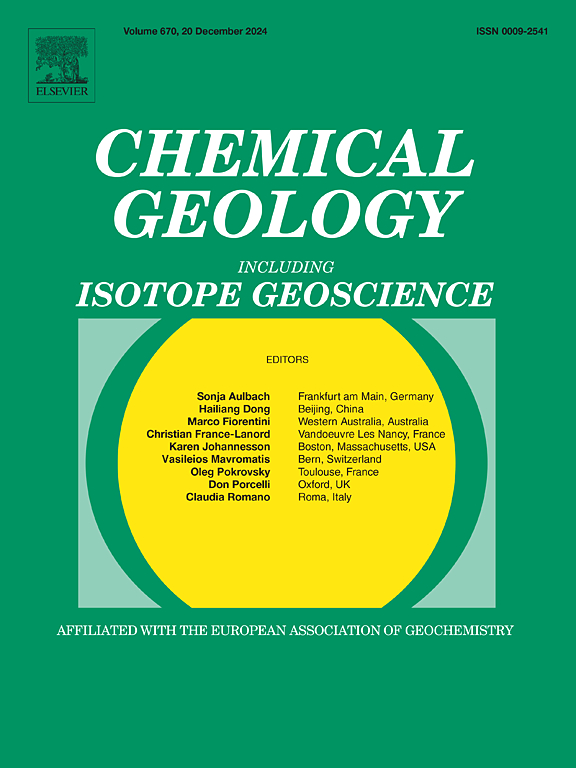通过原位RbSr、UPb和Lu-Hf测定海洋自生矿物的年代:以澳大利亚乔治纳盆地为例
IF 3.6
2区 地球科学
Q1 GEOCHEMISTRY & GEOPHYSICS
引用次数: 0
摘要
原位激光烧蚀-电感耦合等离子体串联质谱(LA-ICP-MS/MS)技术能够以最小的污染进行快速,高分辨率的同位素分析,是自生矿物定年的理想选择。本研究采用LA-ICP-MS/MS三重定年(RbSr, UPb, LuHf)对澳大利亚Georgina盆地中寒武纪(~ 505±3 Ma)海相层序的关键自生矿物进行了测定。分析海绿石、泥晶、白云石和磷灰石的沉积年龄和成岩覆印。海绿石具有高孔隙度、广泛的非石化作用和次生矿物特征,反映了沉积后的蚀变。海绿石原位RbSr测年结果显示,海绿石的年龄较为年轻(452±13 Ma ~ 351±8 Ma),与爱丽斯泉造山运动的两个时期一致。保存较好的泥晶和细粒白云岩的UPb年龄分别为500±17 Ma和513±19 Ma,与沉积年龄一致,而粗粒白云岩的UPb年龄为478±23 Ma,初始Pb较低。3个白云岩样品的磷灰石原位LuHf测年结果分别为497±69 Ma、495±79 Ma和493±74 Ma,尽管存在明显的不确定性,但与沉积窗口重叠。磷矿样品的LuHf年龄为425±49 Ma,与罗定安事件同期。原位UPb磷灰石年龄产生了分散且不真实的年龄,表明LuHf系统为自生磷灰石提供了比UPb更强大的年龄,而RbSr年龄反映了造山运动期间的成岩重置。三个辐射测量系统的整合为重建盆地的沉积和成岩历史提供了一个精细的框架。本文章由计算机程序翻译,如有差异,请以英文原文为准。
Dating of marine authigenic minerals via in situ RbSr, UPb, and Lu–Hf: A case study from the Georgina Basin, Australia
The in situ laser ablation–inductively coupled plasma tandem mass spectrometry (LA-ICP-MS/MS) technique enables rapid, high-resolution isotopic analysis with minimal contamination, ideal for dating authigenic minerals. This study employs LA-ICP-MS/MS triple dating (Rb![]() Sr, U
Sr, U![]() Pb, Lu
Pb, Lu![]() Hf) on key authigenic minerals from the mid-Cambrian (∼505 ± 3 Ma) marine sequence of Australia's Georgina Basin. Glauconite, micrite, dolomite, and apatite were analyzed to constrain depositional ages and diagenetic overprints. Glauconite exhibits high porosity, extensive illitization, and secondary minerals, reflecting post-depositional alteration. In situ Rb
Hf) on key authigenic minerals from the mid-Cambrian (∼505 ± 3 Ma) marine sequence of Australia's Georgina Basin. Glauconite, micrite, dolomite, and apatite were analyzed to constrain depositional ages and diagenetic overprints. Glauconite exhibits high porosity, extensive illitization, and secondary minerals, reflecting post-depositional alteration. In situ Rb![]() Sr dating of glauconite yielded systematically younger ages (452 ± 13 Ma to 351 ± 8 Ma) coeval with two episodes of the Alice Springs Orogeny. Well-preserved micrite and fine dolomite yielded U
Sr dating of glauconite yielded systematically younger ages (452 ± 13 Ma to 351 ± 8 Ma) coeval with two episodes of the Alice Springs Orogeny. Well-preserved micrite and fine dolomite yielded U![]() Pb ages of 500 ± 17 Ma and 513 ± 19 Ma, consistent with the depositional age, whereas a coarser dolomite yielded a younger age of 478 ± 23 Ma with lower initial Pb. In situ Lu
Pb ages of 500 ± 17 Ma and 513 ± 19 Ma, consistent with the depositional age, whereas a coarser dolomite yielded a younger age of 478 ± 23 Ma with lower initial Pb. In situ Lu![]() Hf dating of apatite from three dolostone samples yielded ages of 497 ± 69 Ma, 495 ± 79 Ma, and 493 ± 74 Ma, overlapping with the depositional window despite notable uncertainties. A phosphorite sample yielded a Lu
Hf dating of apatite from three dolostone samples yielded ages of 497 ± 69 Ma, 495 ± 79 Ma, and 493 ± 74 Ma, overlapping with the depositional window despite notable uncertainties. A phosphorite sample yielded a Lu![]() Hf age of 425 ± 49 Ma, coeval with the Rodingan event. In situ U
Hf age of 425 ± 49 Ma, coeval with the Rodingan event. In situ U![]() Pb apatite ages yielded dispersed and unrealistic ages demonstrating that the Lu
Pb apatite ages yielded dispersed and unrealistic ages demonstrating that the Lu![]() Hf system provides more robust ages than U
Hf system provides more robust ages than U![]() Pb for authigenic apatite, whereas Rb
Pb for authigenic apatite, whereas Rb![]() Sr ages reflect diagenetic resetting during orogeny. The integration of three radiometric systems provides a refined framework for reconstructing the basin's depositional and diagenetic history.
Sr ages reflect diagenetic resetting during orogeny. The integration of three radiometric systems provides a refined framework for reconstructing the basin's depositional and diagenetic history.
求助全文
通过发布文献求助,成功后即可免费获取论文全文。
去求助
来源期刊

Chemical Geology
地学-地球化学与地球物理
CiteScore
7.20
自引率
10.30%
发文量
374
审稿时长
3.6 months
期刊介绍:
Chemical Geology is an international journal that publishes original research papers on isotopic and elemental geochemistry, geochronology and cosmochemistry.
The Journal focuses on chemical processes in igneous, metamorphic, and sedimentary petrology, low- and high-temperature aqueous solutions, biogeochemistry, the environment and cosmochemistry.
Papers that are field, experimentally, or computationally based are appropriate if they are of broad international interest. The Journal generally does not publish papers that are primarily of regional or local interest, or which are primarily focused on remediation and applied geochemistry.
The Journal also welcomes innovative papers dealing with significant analytical advances that are of wide interest in the community and extend significantly beyond the scope of what would be included in the methods section of a standard research paper.
 求助内容:
求助内容: 应助结果提醒方式:
应助结果提醒方式:


